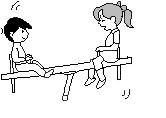


| G5.5 N-�ϰ� (����) ~��� |
Examples
| (i) Indicating a reciprocal partner | |||
| (1) | A: | ��Ƽ�� ���� �� �ؿ�? |  |
| B: | �����ϰ� ��ȭ�ؿ� | ||
| (ii) Indicating an accompanying entity or coparticipant | |||
| (2) | A: | ��Ƽ�� ���� �� �ؿ�? | |
| B: | �����ϰ� (����) �����ؿ�. | ||
| (3) | ����: | ����Ŭ�� ���Ŀ� �� �ؿ�? |  |
| ����Ŭ: | �����ϰ� (����) �����ؿ�. | ||
| (4) | ����: | ����Ŭ��, ����Ͽ� �� �ؿ�? |  |
| ����Ŭ: | �����ϰ� (����) �״Ͻ��Ŀ�. | ||
Notes
1. We already learned in G3.4
one usage of -�ϰ�
in the sense of 'and' in Engish (conjoining two nouns). More examples,
| Conjoining two nouns:
N-�ϰ�
N
��. ����� ���� ȫ���̿���. ȫ�ῡ �θ���ϰ� ������ �־��. |
|
| ��. A: ��� ������? B: ��ȭ���� ����? A: ��ȭ���� �� �緯 ������? B: �����ϰ� ������ �緯 ���� [���� 'trousers', ���� 'shoes'] |
 |
2. 'N-�ϰ�'
has another usage that is parallel to English 'with N', which can subsume
two sub-types:
(i) Indicating a reciprocal partner
in those reciprocal activities, as in (1) and (2).
Other reciprocal actions/activities:
���̰� ��Ƽ���ϰ� ����ؿ�.
���ٰ� ����Ŭ�ϰ� ��ȥ�ؿ�.
(ii) Indicating an accompanying entity or co-participant in a joint action or activity, as in (3) and (4) in the sense of 'together with' or 'along with'.
Other joint actions or activities:
�����ϰ� ���� ��ȭ���� ����.
���̰� �����ϰ� ���� ��ħ�� �Ծ��.
In this case, ���� 'together' is optionally allowed, thus N-�ϰ� (����) ~���.
[����] Describe the following pictures, using -�ϰ�.
����:
���ٰ� ����Ŭ�ϰ� �״Ͻ��� �Ŀ�.
 |
(1) ��Ƽ�갡 �����ϰ� ��ȭ�ؿ�.

���� ��Ƽ��
(2) ������ Ƽ���ϰ� �üҸ� Ÿ��.

Ƽ�� ����
(3) ��Ƽ�갡 �����ϰ� ����ؿ�.

��Ƽ�� ����